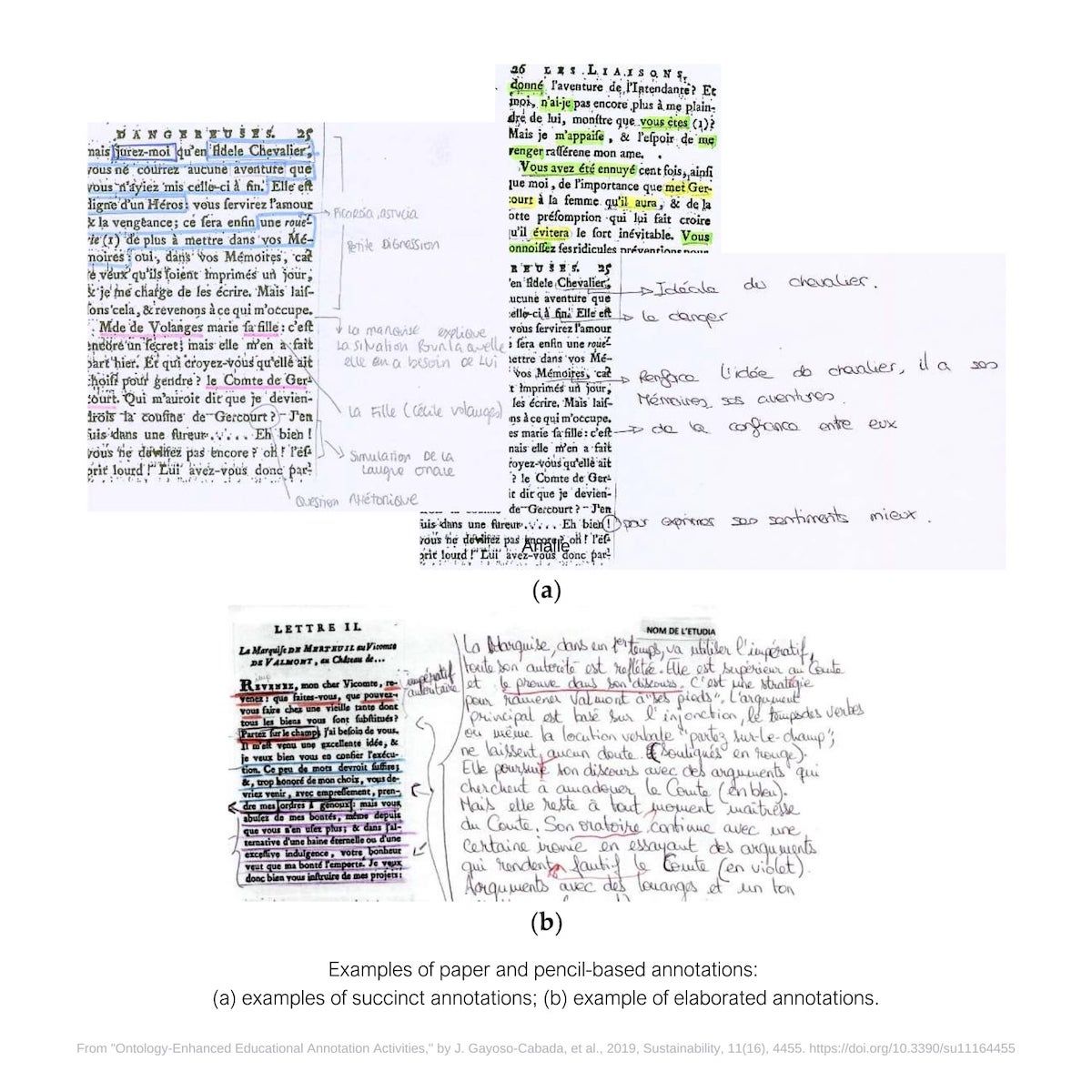Have you ever written inside of a book?
It can feel a little mischievous to write on the pages of a book, as if we're breaking some rule. As children, we were taught not to write in our school books or library books, so annotations seemed taboo.
But what if writing in a book was not only OK but also encouraged?
Annotation is a practical and valuable way to engage with text, whether it’s a novel, textbook, or article. When done correctly, annotation can help you engage with the text, identify key points and themes, and even improve your comprehension.
In this article, we'll discuss what it means to annotate and how it can benefit your learning and comprehension. Get ready to learn how to annotate effectively with this five-step guide.

Annotating is the act of adding notes, comments, or highlighting to a text as we read through it. These notes can be about anything — our thoughts, reactions, questions — and they can be written in any way we want, from symbols to complete sentences. This form of note-taking can help us remember key information in any text, whether it's a textbook for school or a novel we enjoy.
Although writing inside books has generally been discouraged and frowned upon in recent decades, the practice of annotation dates back centuries. The word “annote” from Latin “ad” meaning "to" + “notare” meaning "to mark or note," was first recorded in the mid-15th century.
Annotation has traditionally been used for scholars, researchers, and students to engage with texts. But it's also widely used by many others, from business professionals to authors like Mark Twain. His humorous marginalia is now collected and exhibited in libraries.
There are many ways to annotate a document, from underlining and highlighting to writing notes in the margins. Regardless of their form, annotations serve the same purpose — to help us better engage with and understand the text.

Annotating is an active reading strategy that facilitates the critical understanding of information in a text. As we note our thoughts and reflections, we can better engage with the material, identify main points and themes, and even improve our comprehension.
There are many benefits to annotating, whether we're reading for school or pleasure. Among the most significant are the following:

Highlight, annotate or take notes from anywhere, and it's easily linked to a selected topic in your Knowledge Base.
Learn more
Knowing how to annotate is a valuable skill for anyone, whether you're a student, professional, or lifelong self-learner. If you'd like to use annotation to discover and recall key information from your reading, here are a handful of steps to get started.
The first step is to choose your annotation tools. The tools that you choose will depend on the format of your text. If you’re annotating the pages of a book or printed text on a piece of paper, you will need different tools than if you’re annotating an electronic document on a computer or tablet.
Some standard annotation tools for paper texts include:
If you're using a physical book, choose materials that won't damage the pages. This means avoiding pens and markers with bleed-through ink and opting for pencils instead. Highlighters are also a good option, as long as they don't bleed through the pages.
For electronic texts, you can use digital versions of many of the same tools as you would for paper texts. However, some annotation-specific tools may come in handy. These include:
If you're reading on a Kindle or other e-reader, you may be limited in the tools you can use. Check your device's documentation to see what options are available. No matter what format you're using, choosing tools you're comfortable with is key. This will make annotation more enjoyable and effective.
Now that you've selected tools, it's time to choose an annotation strategy. There are many ways to annotate, so experiment to find what works best for you. There are several common annotation strategies to try:
Once you choose a strategy that fits your reading intent, you're ready to start annotating.
Armed with your tools and strategy, you're ready to annotate For your first read, you will simply scan the text. During this initial read-through, there are a few key things to look for:
As you scan, note anything that confuses you or doesn't make sense. When you do a close reading, you'll want to pay attention to these areas.

After a quick scan of the text, it's time for a closer look. Read the text again, focusing on the bigger picture to identify the author's main points. This step doesn't include close reading of the text, but you'll want to take a little more time and skim the text more closely than in your initial scan.
During this read-through, your goal is to discover the thesis or central argument of the text. Take some time to note the format of the text, how the information is structured, and how the author supports their claims. Underline or highlight the major ideas of each section as you skim. Lastly, paraphrase the article in your own words near the header or at the end of the text.
Once you understand the main points, you're ready to do a close reading. This is where you'll finally slow down, focus on the details, and do some note-taking.
Start at the beginning and slowly re-read the text. Keep your annotation strategy in mind as you read. Knowing whether you want to take a descriptive approach, use the evaluative method, or try another strategy will help you look for the areas you should annotate.
Whichever strategy you use, there are a few helpful things to keep in mind:
Adding annotations to a text is an individual process, so there’s no right or wrong way. However, you can use these tips to maximize your annotations and ensure they're helpful.
Whether reading for leisure or learning, knowing how to annotate can benefit your experience. Using annotations effectively improves your understanding of a text and enhances your memory and comprehension. Annotating allows you to take a more active role in your self-learning so you're not just passively reading but critically engaging with the material.
If you're new to annotation, start small. Pick one article or chapter and experiment with different annotation strategies. As you become more comfortable, you can try different approaches and find the one(s) that work best for you. With time and practice, annotating will become second nature — and you'll be able to reap all the benefits of this powerful learning tool.

Highlight, annotate or take notes from anywhere, and it's easily linked to a selected topic in your Knowledge Base.
Learn moreI hope you have enjoyed reading this article. Feel free to share, recommend and connect 🙏
Connect with me on Twitter 👉 https://twitter.com/iamborisv
And follow Able's journey on Twitter: https://twitter.com/meet_able
And subscribe to our newsletter to read more valuable articles before it gets published on our blog.
Now we're building a Discord community of like-minded people, and we would be honoured and delighted to see you there.